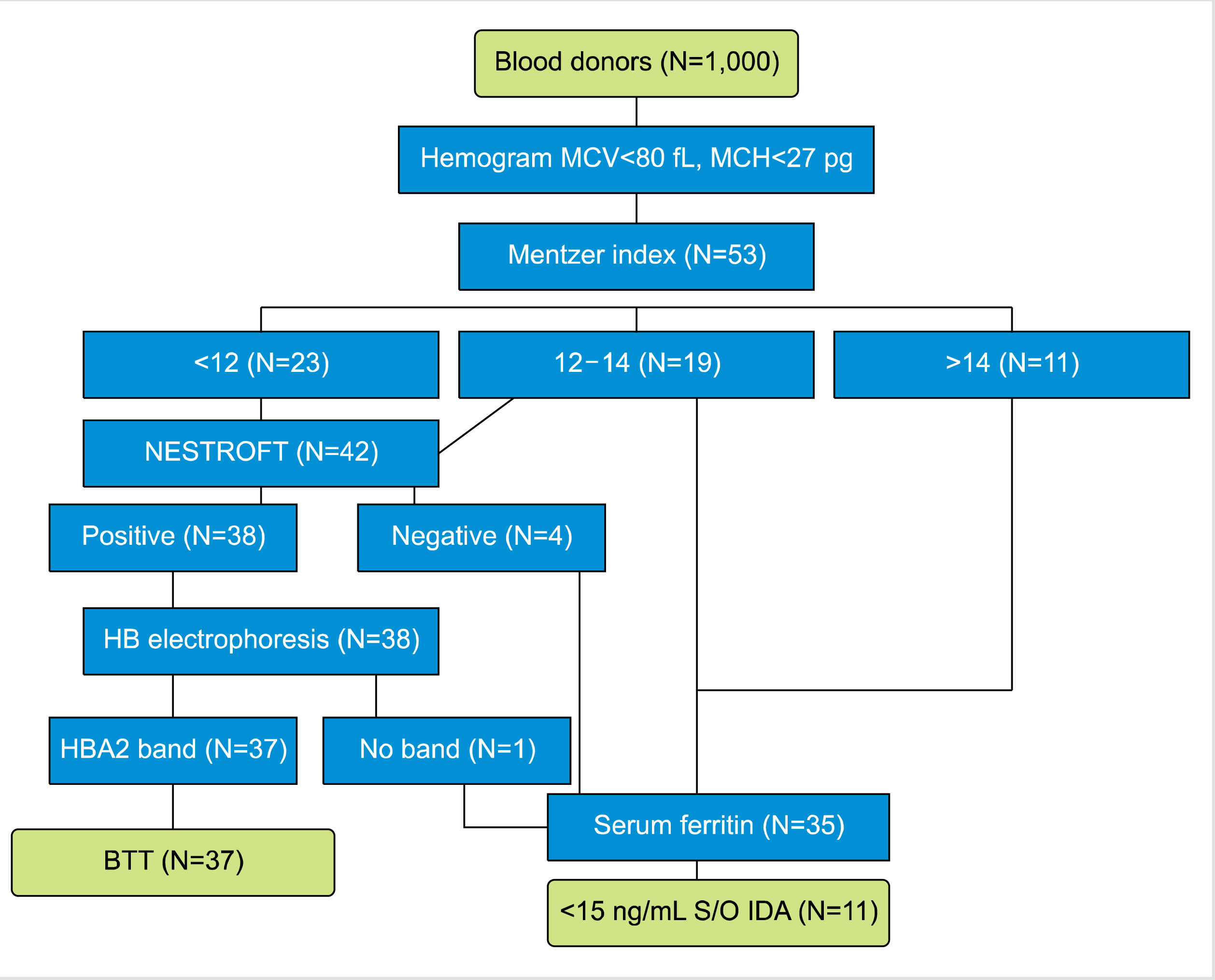Blood Res.
2020 Sep;55(3):169-174. 10.5045/br.2020.2020219.
Utility of screening tools to differentiate beta thalassemia trait and iron-deficiency anemia - do they serve a purpose in blood donors?
- Affiliations
-
- 1Department of Transfusion Medicine, All India Institute of Medical Sciences, New Delhi, India
- 2Department of Transfusion Medicine, Government Medical College and Hospital, Chandigarh, India
- 3Department of Pathology, Government Medical College and Hospital, Chandigarh, India
- KMID: 2507057
- DOI: http://doi.org/10.5045/br.2020.2020219
Abstract
- Background
The aim of this study was to estimate the prevalence of the beta thalassemia trait (BTT) and differentiate it from iron-deficiency anemia (IDA) among blood donors.
Methods
A total of 1,000 samples from blood donors were subjected to complete hemogram with red blood cell indices. Further, Mentzer index (MI) was calculated for samples with mean corpuscular volume (MCV) below 80 fL and mean corpuscular hemoglobin (MCH) below 27 pg. Samples with Mentzer index <12 were subjected to naked-eye single-tube red cell osmotic fragility test (NESTROFT) followed by hemoglobin electrophoresis in positive cases. Serum ferritin was assessed in NESTROFT-negative cases.
Results
The prevalence of BTT among blood donors was 3.7% and that of microcytosis among donors was 8.6%. The prevalence of BTT among microcytic donors was 41.8% while that among those with IDA was 11.6%. A value of MI <13 was highly sensitive in the diagnosis of BTT. MI >13 was found to have both high specificity and high sensitivity for diagnosing IDA.
Conclusion
A moderately high prevalence of BTT was observed among blood donors. Presently, no screening program is mandatory for screening of BTT among blood donors. Indices like MCV, MCH, and Mentzer Index were thus found to be effective to screen for BTT and IDA among blood donors, and NESTROFT was a cost-effective mass screening method to differentiate BTT and IDA.
Figure
Reference
-
1. Greer JP, Foerster J, Rodgers GM, Paraskevas F, Glader B, Means RT. 2009. Thalassemias and related disorders: quantitative disorders of hemoglobin synthesis. Wintrobe's clinical hematology. 12th ed. Lippincott Williams & Wilkins;Philadelphia, PA: p. 1082–131.2. Kaushansky K, Lichtman M, Beutler E, Kipps T, Prchal J, Seligsohn U. 2010. The thalassemias: disorders of globin synthesis. Williams hematology. 8th ed. McGraw-Hill;New York, NY: p. 675–708.3. Modell B, Darlison M. 2008; Global epidemiology of haemoglobin disorders and derived service indicators. Bull World Health Organ. 86:480–7. DOI: 10.2471/BLT.06.036673. PMID: 18568278. PMCID: PMC2647473.
Article4. Vichinsky EP. 2005; Changing patterns of thalassemia worldwide. Ann N Y Acad Sci. 1054:18–24. DOI: 10.1196/annals.1345.003. PMID: 16339647.
Article5. Flint J, Harding RM, Boyce AJ, Clegg JB. 1998; The population genetics of the haemoglobinopathies. Baillieres Clin Haematol. 11:1–51. DOI: 10.1016/S0950-3536(98)80069-3. PMID: 8353314.6. Madan N, Sharma S, Sood SK, Colah R, Bhatia LH. 2010; Frequency of b-thalassemia trait and other hemoglobinopathies in northern and western India. Indian J Hum Genet. 16:16–25. DOI: 10.4103/0971-6866.64941.7. Mehta BC, Dave VB, Joshi SR, Baxi AJ, Bhatia HM, Patel JC. 1972; Study of hematological and genetical characteristics of Cutchhi Bhanushali community. Indian J Med Res. 60:305–11. PMID: 5035201.8. Verma IC, Saxena R, Kohli S. 2011; Past, present & future scenario of thalassaemic care & control in India. Indian J Med Res. 134:507–21.9. Kattamis C, Efremov G, Pootrakul S. 1981; Effectiveness of one tube osmotic fragility screening in detecting beta-thalassaemia trait. J Med Genet. 18:266–70. DOI: 10.1136/jmg.18.4.266. PMID: 7277419. PMCID: PMC1048730.
Article10. Means RT, Glader B. Greer JP, Arber DA, Glader B, editors. 2014. Anemia: general considerations. Wintrobe's clinical hematology. 13th ed. Lippincott Williams & Wilkins;Philadelphia, PA: p. 587–616.11. Mohanty D, Colah RB, Gorakshakar AC, et al. 2013; Prevalence of b-thalassemia and other haemoglobinopathies in six cities in India: a multicentre study. J Community Genet. 4:33–42. DOI: 10.1007/s12687-012-0114-0.12. Chatterjee N, Mishra A, Soni R, Kulkarni H, Mamtani M, Shrivasatava M. 2010; Bayesian estimates of the prevalence of b-thalassemia trait in voluntary blood donors of central India: a survey. Hemoglobin. 34:548–60. DOI: 10.3109/03630269.2010.526488.13. Kulkarni P, Masthi NR, Niveditha S, Suvarna R. 2013; The prevalence of the beta thalassemia trait among the pregnant women who attended the ANC Clinic in a PHC, by using the NESTROF Test in Bangalore, Karnataka. J Clin Diagn Res. 7:1414–7. DOI: 10.7860/JCDR/2013/5286.3149. PMID: 23998078. PMCID: PMC3749648.
Article14. Tiwari AK, Chandola I, Ahuja A. 2010; Approach to blood donors with microcytosis. Transfus Med. 20:88–94. DOI: 10.1111/j.1365-3148.2009.00980.x. PMID: 20003131.
Article15. Tailor HJ, Patel PR. 2019; A prospective study of hidden cases of beta thalassemia trait in voluntary blood donors at tertiary care hospital of South Gujarat. Trop J Pathol Microbiol. 5:580–4. DOI: 10.17511/jopm.2019.i08.12.
Article16. Kumar R, Gupta S, Jindal A, Kakkar S, Kaur A. 2015; Screening of b-thalassemia trait and other hemoglobinopathies among blood donors in Punjab. Int J Med Public Health. 5:106–9. DOI: 10.4103/2230-8598.151273.17. Rosline H, Ahmed SA, Al-Joudi FS, Rapiaah M, Naing NN, Adam NA. 2006; Thalassemia among blood donors at the Hospital Universiti Sains Malaysia. Southeast Asian J Trop Med Public Health. 37:549–52. PMID: 17120978.18. Soliman AR, Kamal G, Elsalakawy Walaa A, Sallam Mohamed TH. 2014; Blood indices to differentiate between b-thalassemia trait and iron deficiency anemia in adult healthy Egyptian blood donors. Egypt J Haematol. 39:91–7. DOI: 10.4103/1110-1067.148223.19. Sumera A, Ahmed S, Adnan Ali SM, Khanani R. 2012; Evaluation of NESTROFT as a marker of differentiation between b-thalassemia trait & iron deficiency anemia. Int J Collab Res Intern Med Public Health. 4:1560–6.20. Mondal SK, Mandal S. 2016; Prevalence of thalassemia and hemo-globinopathy in eastern India: A 10-year high-performance liquid chromatography study of 119,336 cases. Asian J Transfus Sci. 10:105–10. DOI: 10.4103/0973-6247.175424. PMID: 27011683. PMCID: PMC4782486.
Article21. Tiwari AK, Chandola I. 2009; Comparing prevalence of iron deficiency anemia and beta thalassemia trait in microcytic and non-microcytic blood donors: suggested algorithm for donor screening. Asian J Transfus Sci. 3:99–102. DOI: 10.4103/0973-6247.53883. PMID: 20808655. PMCID: PMC2920481.
Article


